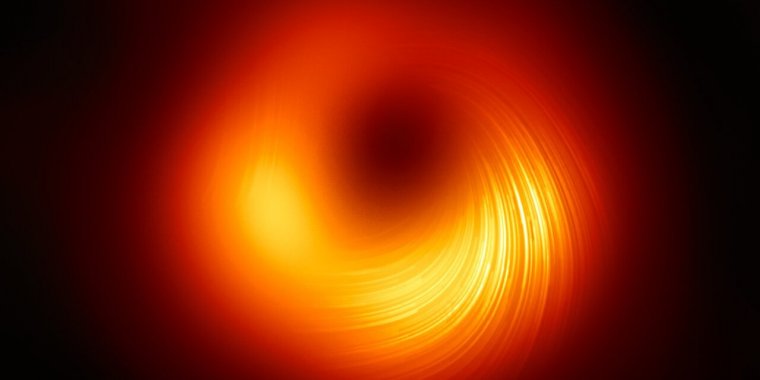| News / Space News |
Astronomers image magnetic fields at the edge of M87’s black hole
The Event Horizon Telescope (EHT) collaboration, who produced the first ever image of a black hole, has today revealed a new view of the massive object at the centre of the Messier 87 (M87) galaxy: how it looks in polarised light. This is the first time astronomers have been able to measure polarisation, a signature of magnetic fields, this close to the edge of a black hole.

A view of the M87 supermassive black hole in polarised light. Photo: ESO
The observations are key to explaining how the M87 galaxy, located 55 million light-years away, is able to launch energetic jets from its core.
“We are now seeing the next crucial piece of evidence to understand how magnetic fields behave around black holes, and how activity in this very compact region of space can drive powerful jets that extend far beyond the galaxy,” says Monika Mościbrodzka, Coordinator of the EHT Polarimetry Working Group and Assistant Professor at Radboud University in the Netherlands.
On 10 April 2019, scientists released the first ever image of a black hole, revealing a bright ring-like structure with a dark central region — the black hole’s shadow. Since then, the EHT collaboration has delved deeper into the data on the supermassive object at the heart of the M87 galaxy collected in 2017. They have discovered that a significant fraction of the light around the M87 black hole is polarised.
Light becomes polarised when it goes through certain filters, like the lenses of polarised sunglasses, or when it is emitted in hot regions of space where magnetic fields are present.
In the same way that polarised sunglasses help us see better by reducing reflections and glare from bright surfaces, astronomers can sharpen their view of the region around the black hole by looking at how the light originating from it is polarised. Specifically, polarisation allows astronomers to map the magnetic field lines present at the inner edge of the black hole.
“The newly published polarised images are key to understanding how the magnetic field allows the black hole to 'eat' matter and launch powerful jets,” says EHT collaboration member Andrew Chael, a NASA Hubble Fellow at the Princeton Center for Theoretical Science and the Princeton Gravity Initiative in the US.
The bright jets of energy and matter that emerge from M87’s core and extend at least 5000 light-years from its centre are one of the galaxy’s most mysterious and energetic features. Most matter lying close to the edge of a black hole falls in. However, some of the surrounding particles escape moments before capture and are blown far out into space in the form of jets.
Astronomers have relied on different models of how matter behaves near the black hole to better understand this process. But they still don’t know exactly how jets larger than the galaxy are launched from its central region, which is comparable in size to the Solar System, nor how exactly matter falls into the black hole.
With the new EHT image of the black hole and its shadow in polarised light, astronomers managed for the first time to look into the region just outside the black hole where this interplay between matter flowing in and being ejected out is happening.
“The observations suggest that the magnetic fields at the black hole’s edge are strong enough to push back on the hot gas and help it resist gravity’s pull. Only the gas that slips through the field can spiral inwards to the event horizon,” explains Jason Dexter, Assistant Professor at the University of Colorado Boulder, US, and Coordinator of the EHT Theory Working Group. (ESO)
YOU MAY ALSO LIKE





